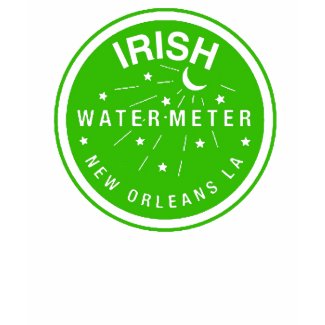Directly after Mardi Gras when the parades end we celebrate St. Patrick's Day. New Orleans has many Irish and a lot of the work done on the city was done by Irish see history here: http://www.neworleansonline.com/neworleans/multicultural/multiculturalhistory/irish.html
"An early wave of Irish immigrants, fleeing British persecution at the end of the 1700s, landed in New Orleans and became well integrated into the economy and social life of the city. The first St. Patrick’s Day celebration was held in 1809. Irish social and benevolent organizations were formed, and Irish theater thrived. The still existing St. Patrick’s Church was founded in 1833 because Irish parishioners wanted to attend services in English, not French".
So I do Mardi Gras Shirts and Irish shirts to wear at the parades. St. Patrick Day in New Orleans has several parades. See them here http://www.zazzle.com/figstreetstudio/irish+gifts?rf=238720872070265283
More on Irish coming to New Orleans at the La State Museum: http://lsm.crt.state.la.us/cabildo/cab8.htm
New Orleans was the second leading port of entry in the United States during the antebellum period. Between 1820 and 1860 over 550,000 immigrants came to New Orleans, although the Crescent City lagged far behind its top competitor, New York City. Still, by 1850 about one-quarter of Louisiana's and the majority of New Orleans' white population was foreign-born.
Several factors drew immigrants to New Orleans. European immigrants often found it less expensive to go to New Orleans than to Atlantic ports. The large vessels that carried southern agricultural products to Europe, especially cotton, returned to New Orleans with less bulky manufactured goods and had enough room to offer bargain fares to passengers.
Immigrants from Ireland also settled in Louisiana early on. The Crescent City held its first St. Patrick's Day celebration in 1809. The major influx of Irish, most of whom were peasants, came after 1830, especially following potato blights of the 1840s. By 1860 Irish numbered over 24,000 in New Orleans.
St. Patrick's CemeteryGeorge François Mugnierc. 1890This photograph shows antebellum Irish tombs in New Orleans.
In contrast to German immigrants, most Irish who arrived at the port of New Orleans stayed in the city, primarily because they could not afford passage farther inland. Crowding into the city's riverfront neighborhoods, they strained its limited housing, employment, and education. Forced to compete with slaves and free blacks at the bottom of the economy, many New Orleans Irish took low-paying, often dangerous manual jobs, such as digging canals and ditches, building roads, levees, and railroads, and laboring on the docks and in the warehouses. The mortality rate was especially high among canal diggers, who were highly susceptible to yellow fever, malaria, and cholera.




No comments:
Post a Comment